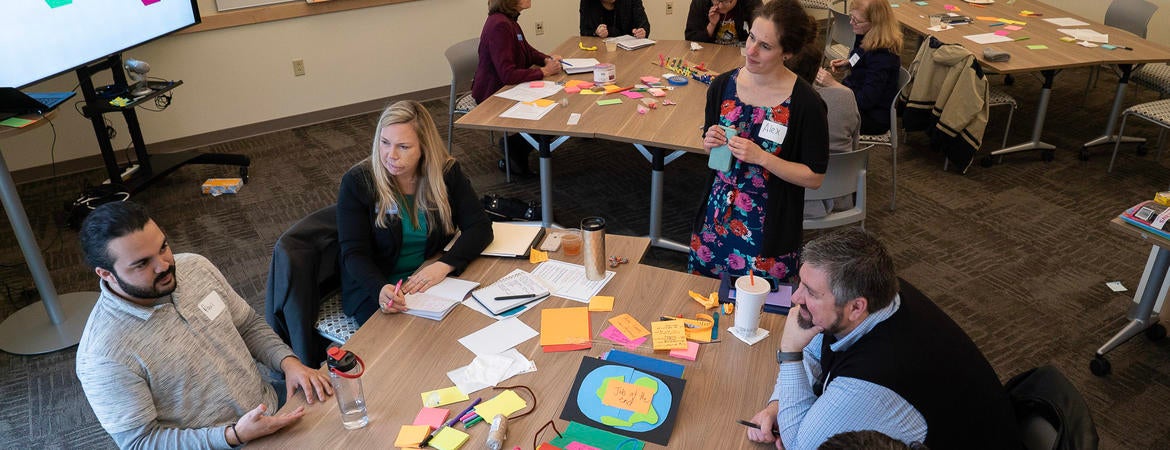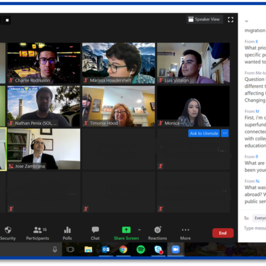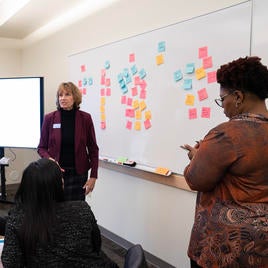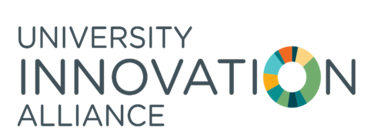
Over the past two years, I have had the pleasure of working with an outstanding team of dedicated UCR staff, faculty, and students through a journey of exploration and experimentation -- all with the goal of empowering UCR students to reach their career goals. This work was part of the University Innovation Alliance’s “Bridging the Gap from Education to Employment” project, funded by Strada Education Network.
The UCR team started with a simple question: how might we better prepare UCR undergraduate students - particularly those from first-generation and low-income backgrounds - for careers? To answer this question, the team used human-centered design methodologies: applied an empathy-based approach to understand student needs; brainstormed many, many possible ideas for meeting those needs; and ‘tested’ those solutions to get feedback to ‘fail forward’ and make improvements rapidly. Over the course of a year, the BGEE team conducted in-depth conversations with over 160 students from all UCR colleges, years, and corners of campus to understand the barriers they face on their career paths and get their feedback on ways to smooth the path from college to career. That exploration culminated in a new model for internships: where students had the chance to work in a group of their peers to solve a real-world problem for a real employer - while receiving mentorship and a stipend -- all while never leaving campus (or in the case of 2020, Zoom).
This idea came to fruition thanks to a collaboration with the U.S. Environmental Protection Agency - a longstanding partner of UCR and a member of the UIA’s employer advisory board. In Summer 2020, the UCR Career Center and the U.S. EPA Region 9 co-created an internship program. Using a grant from the UIA, the Career Center hired six UCR undergraduates who collaboratively developed recommendations for reducing food waste on campus. These students participated in professional development from the Career Center; exposure to high-level EPA leaders during weekly guest speakers, mentorship from both UCR faculty/graduate students and EPA staff; and attended a virtual E.P.A conference. The internship program created a sense of community, opened up a new world of career goals and opportunity, and built their confidence – all while providing them with the chance to do what UCR students care so deeply about: contributing to their community. To hear about the impact of the program directly from student participants, check out this video.
During a summer where opportunities disappeared due to the COVID-19 pandemic , UCR staff and the EPA worked creatively and collaboratively to adapt this internship program to a virtual environment. I’ve learned so much through this experience, and the many staff, faculty, students, and employers with whom I’ve worked. And while our project was focused specifically on career preparation, so much of what I’ve learned is applicable to how we approach collaboration, solve big problems, and support student success. I hope that these insights might prove valuable to others:
- The best place to start is with the people you are trying to reach. In the BGEE project, the team engaged students in conversations to understand their needs. Rather than make assumptions about students’ experiences, they connected with dozens of students. Perhaps just as importantly, the team did not simply survey students, but really spoke with them - having true conversations to understand their experiences at UCR, their priorities, and their goals. By doing so, the team gained unexpected insights - for example, that UCR students preferred on-campus jobs to off-campus jobs or internships in part because of parking. With UCR’s parking challenges, it was too difficult to leave during the day for an off-campus internship and risk losing the parking spot needed for an afternoon class. While few people on the team would have connected parking and career preparation before this project, our approach unearthed that connection - and prompted exploration of how UCR could bring employers and internships to students, instead of the other way around. Taking a people-first approach led to unexpected solutions.
- Cross-campus collaboration leads to a sum greater than its parts. One key method of the project was convening many different perspectives, democratizing the brainstorm process, and combining the most exciting ideas into an unexpected result. The team used brainstorming techniques that encourage ‘divergent’ thinking - where each individual shares as many ideas (no matter how unexpected or wild) before the team ‘converges’ around the ideas they find most exciting. By using a lot of Post-Its, this process also made sure that the ideas weren’t coming from only the loudest voice or the first one to speak (who, I will admit, is too often me!). It was this process - repeated many times over many months - that generated elements of the Bridge Experience internship program: students would work in interdisciplinary groups, employers would come to campus, students would present their work in a final presentation. These ideas were all the result of different team members with different perspectives, and culminated in a meaningful program for students.
- Experimentation encourages innovation and leads to unexpected learning: Many fields value the process of experimentation - whether in scientific research, market research, or beta testing new technology projects. This same approach is critical - but undervalued - in student success efforts. In the BGEE project, the team was tasked with developing a small-scale pilot to test whether the program would have its desired impact. For the BGEE project, there were many questions to answer: would the experience be meaningful to employers? Would students gain professional skills? Would it increase confidence? By testing the program on a small scale, the team was willing to take risks and - particularly important during summer 2020 and the COVID-19 pandemic - felt comfortable adapting the program quickly. The added benefit of taking an experimental approach - where the goal is to learn - was that there were many unexpected discoveries through the process. In the case of the Bridge Experience, the team learned that the virtual environment had a number of unexpected benefits. For example, the virtual environment made it possible for employer mentors to participate in weekly group reflections, leading to an increased sense of community. Students were also able to participate in an EPA conference for free (and without travel) - providing exposure to the professional world of environmentalism. Furthermore, using Zoom’s written chat function helped the students feel more comfortable engaging with guest speakers.
- Design with students. Over the course of the year, the BGEE project hired student interns to work on the effort, including a student intern through UCR’s 2019 Summer Learn & Earn Program, and four interns funded by the University Innovation Alliance and hired using the micro-internship platform Parker Dewey. These students were invaluable to the project - both for their work interviewing their peers as well as the perspective and expertise they brought to the team. In recognition of their lived expertise, these students were members of the team, working side-by-side with administrators and faculty to develop the program. Their involvement was invaluable in developing the program - for example, their input led to an added mentorship component to the internship program; one of the elements that the interns found most valuable. I hope that this can serve as an example to other student success efforts: by engaging students as partners in problem-solving, we build better solutions.
I recognize that many of these learnings might seem like a luxury - and impractical during times when our capacity is stretched as thin as it is now thanks to COVID-19. I would also argue that now is exactly the time to think about doing our work differently: to make sure we’re starting with students, encouraging cross-campus collaboration, being willing to experiment, and - most importantly - turning to students for their expertise. These are small changes that can help make student success professionals at UCR and beyond better able to face the unprecedented challenges of our era.
In closing, I want to thank the project team members, current and past, who worked so hard on this project - and provided me so many moments of laughter and learning along the way. I want to particularly thank Sean Gil, Elizabeth Montgomery, and Charlie Rodnuson (former Career Specialist) whose creativity, open-mindedness, incredibly hard work, and - most of all - unflappable commitment to students made this project a reality at UCR.
I also want to thank six UC undergraduate students who taught me about life at UCR, who interviewed dozens and dozens of students, who worked side-by-side with UCR staff and administrators, and whose commitment to improve UCR for their classmates and future students inspired and motivated me constantly. Anser, Elizabeth, Haley, Jonathan, Julia, Maricza -- it has been the greatest privilege to work with you all. Being the first to do something is always scary. You took on a difficult, ambiguous project - and showed just what incredible scholar-practitioners can do in a team.
Alexandra Lozanoff, M.P.P
Regional Director & University Innovation Alliance Fellow
Bridging the Gap from Education to Employment (BGEE)


